The Yau Ma Tei project involves the Cathay Camera club documenting one of the oldest areas of Hong Kong in collaboration with the Royal Asiatic Society. A book based on the photographs and the history of the area is in production and is expected to be published in 1999. Some examples of the photographs taken by club members for this project are shown on this page. Click on a picture for a larger view.
The official website for the book is here and you can order it online if you wish. The pictures in the book are of far higher quality than is possible to show on this webpage.
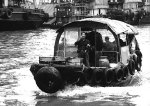 Typhoon Shelter by Charles Slater - Fishing is the traditional lifestyle in Hong Kong. The
earliest inhabitants lived off their daily catch. Even today, seafood is
very popular and a staple of the local diet. Junks, kaidos and sampans
like the one in this picture ply the busy waterways between the cargo
ships and cruise liners. When the weather worsens, these small craft tie
up in typhoon shelters where breakwaters protect them from the might of
the summer storms which besiege Hong Kong.
Typhoon Shelter by Charles Slater - Fishing is the traditional lifestyle in Hong Kong. The
earliest inhabitants lived off their daily catch. Even today, seafood is
very popular and a staple of the local diet. Junks, kaidos and sampans
like the one in this picture ply the busy waterways between the cargo
ships and cruise liners. When the weather worsens, these small craft tie
up in typhoon shelters where breakwaters protect them from the might of
the summer storms which besiege Hong Kong.
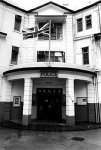 Police Station by David Ensor - The Hong Kong police (no longer 'Royal' since the Handover) are a ubiquitous presence. Many of their police stations provide a glimpse into the historic past of the city. The Police Station in Yau Ma Tei is explored in depth in the book with many photographs of their museum.
Police Station by David Ensor - The Hong Kong police (no longer 'Royal' since the Handover) are a ubiquitous presence. Many of their police stations provide a glimpse into the historic past of the city. The Police Station in Yau Ma Tei is explored in depth in the book with many photographs of their museum.
 Streetlife by David Ensor - A man's best friend is his dog, they say, and this man's dog shares in his masters trials and tribulations. The dog seems to be a bit more relaxed about it though.
Streetlife by David Ensor - A man's best friend is his dog, they say, and this man's dog shares in his masters trials and tribulations. The dog seems to be a bit more relaxed about it though.
 Alley Dogs by Iain Masterton - The fisher folk of Hong Kong always seem to have dogs about. They help to keep down the rats
Alley Dogs by Iain Masterton - The fisher folk of Hong Kong always seem to have dogs about. They help to keep down the rats
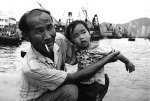 Father and Son by Iain Masterton - Families are very important in Chinese culture. A son, in particular, will be the apple of his father's eye. Even though Hong Kong flats are small, the local Chinese tend to have large families, often with several generations present.
Father and Son by Iain Masterton - Families are very important in Chinese culture. A son, in particular, will be the apple of his father's eye. Even though Hong Kong flats are small, the local Chinese tend to have large families, often with several generations present.
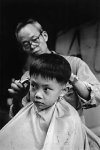 Haircut by Iain Masterton - The old traditional street-side barber shops, many of which are little
more than covered spaces in alleyways, are a legacy of the last of the
emperors, who decreed that all Chinese should wear their hair in the
Manchurian style: bald at the front, braided in a long queue at the
back. While this style is not found anywhere in China in these modern
times, the street side barbers that thrived on this custom remain. They're
cheap, too.
Haircut by Iain Masterton - The old traditional street-side barber shops, many of which are little
more than covered spaces in alleyways, are a legacy of the last of the
emperors, who decreed that all Chinese should wear their hair in the
Manchurian style: bald at the front, braided in a long queue at the
back. While this style is not found anywhere in China in these modern
times, the street side barbers that thrived on this custom remain. They're
cheap, too.
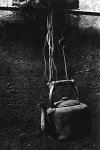 Kettle by Iain Masterton -
Sometimes, the little details are the most important. Tea is a great institution in Chinese life. The curer of ills, the passer of time. It's drunk with friends or family, it's drunk as medicine.
Kettle by Iain Masterton -
Sometimes, the little details are the most important. Tea is a great institution in Chinese life. The curer of ills, the passer of time. It's drunk with friends or family, it's drunk as medicine.
 Sleep by Iain Masterton - Life moves pretty fast in the markets here. Cat-napping after lunch is a time honoured tradition. Even today, many office workers will have a quick snooze after lunch in preparation for a hectic afternoon's work. It's commonplace in the older parts of the city to have outdoor markets, butchers, fishmongers and street hawkers, often right next door to modern supermarkets.
Sleep by Iain Masterton - Life moves pretty fast in the markets here. Cat-napping after lunch is a time honoured tradition. Even today, many office workers will have a quick snooze after lunch in preparation for a hectic afternoon's work. It's commonplace in the older parts of the city to have outdoor markets, butchers, fishmongers and street hawkers, often right next door to modern supermarkets.
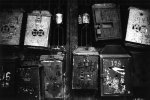 Mailboxes by Ulana Switucha - Hong Kong life is apartment based. Every building has a cluster of mailboxes just by the front door, some personalised, some not. These appear to have been put up by the individual flat owners.
Mailboxes by Ulana Switucha - Hong Kong life is apartment based. Every building has a cluster of mailboxes just by the front door, some personalised, some not. These appear to have been put up by the individual flat owners.
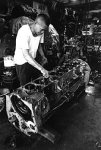 Mechanic by Ulana Switucha - Walking through the traditional areas of the city, it's sometimes startling to find whole streets of artificers, some apparently making tools for others fixing things (in this case engines) on the same street. As the climate is generally warm all year round, most of the machine shops will be open to the street.
The traditional arts are still alive and well.
Mechanic by Ulana Switucha - Walking through the traditional areas of the city, it's sometimes startling to find whole streets of artificers, some apparently making tools for others fixing things (in this case engines) on the same street. As the climate is generally warm all year round, most of the machine shops will be open to the street.
The traditional arts are still alive and well.
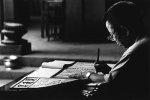 Scribe by Ulana Switucha This man is engaged in the ancient Chinese are of Calligraphy. As the Chinese language is written with ideograms where each character is a picture, it takes a tremendous amount of skill and expertise to be considered a master scribe. People will often have a card or poster with a lucky phrase or fortunate wishes at home or in their place or work inscribed with the beautiful characters drawn by this man or others like him.
Scribe by Ulana Switucha This man is engaged in the ancient Chinese are of Calligraphy. As the Chinese language is written with ideograms where each character is a picture, it takes a tremendous amount of skill and expertise to be considered a master scribe. People will often have a card or poster with a lucky phrase or fortunate wishes at home or in their place or work inscribed with the beautiful characters drawn by this man or others like him.